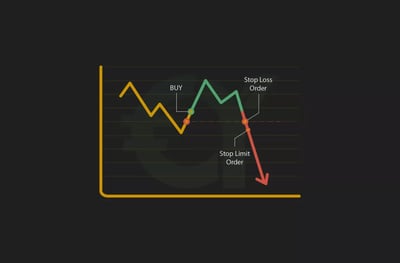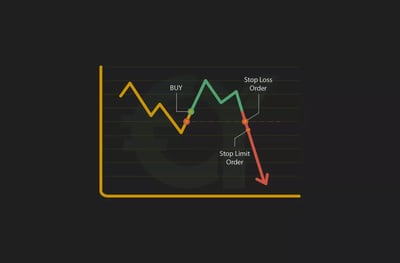For as long as financial investing has been around, investors have relied on placing orders by using a variety of instructions. When you place a trade instruction, you are telling someone what you want to happen to your portfolio. In investing, when we say you instruct someone, this usually means that you instruct your portfolio manager, or you instruct an automated system.
For example, a market order is an instruction to buy or sell an asset, usually immediately, regardless of the price. You would normally do this directly from your broker’s trading platform. What if you want to issue an instruction remotely, or while you sleep? Stop-loss orders and stop-limit orders are two popular ways of accomplishing this. However, it is vital to clearly understand the difference between these two tools. We will explain how they work in this short article.
Key Takeaways
A stop-loss order becomes a market order when triggered and guarantees execution but not price
A stop-limit order becomes a limit order when triggered and guarantees price but not execution
Stop-loss orders are best for traders who prioritize exiting a trade quickly to prevent large losses
Stop-limit orders suit traders who want control over trade price but are willing to risk the trade not going through
Fast market moves can cause stop-loss orders to execute at worse-than-expected prices
Stop-limit orders can fail to execute entirely if the market moves past the set limit too quickly
Both types of orders help automate risk management and reduce reliance on emotional decisions
Understanding the trade-off between execution certainty and price control is key to using stop orders effectively
Stop-Loss Orders Explained
A stop-loss order works best for assets like stocks and share investing, where the value of your asset could drop without you noticing. Remember, not all investors can be full-time traders, so it is common for traders to check their portfolio’s behavior infrequently.
One form of stop-loss order is an order to purchase an asset as its price is climbing and hits a specified stop price. This is called a buy-stop. Alternatively, you can use a different type of stop-loss order to sell an asset as its price is declining and it reaches a designated stop price. This is called a sell-stop.
Most of the time, investors use sell-stop orders as a share price is tanking to protect their earnings in an effort to limit more losses. When the stop price is attained (be it a buy-stop or a sell-stop), the stop-loss order immediately becomes a market order that is executed on the spot.
Why bother with these types of orders? Well, most people insert them to limit losses of a falling share price as the value becomes unfavorable. Alternatively, they try to get in on the action with a specific share whose price is climbing fast.
Think of it this way: You own some Tesla shares. They are currently priced at $20, but due to some vehicle quality issues leading to a recall, the price has been losing value fast. You set a stop-loss order for $15 because, if the stock hits $15, you will have seen enough and you want to sell your Tesla shares. When it hits the price, your instruction converts to a market order, which means your shares get sold immediately.
However, note that with this type of order, you cannot guarantee a specific price. Your stocks will go on sale as the price is $15, but there is no way of knowing whether you will get that price. Sometimes a price falls so fast you could earn even less than your designated price by the time the sale goes through. You could make $13 if the stock is tumbling rapidly, or it could rebound, and you sell it at $16.
Stop-Limit Orders
As you can see, a stop-loss order can be unpredictable. You may have an intention to sell or buy at a certain price, but you cannot guarantee it. The stop-limit order is there to take away some of this unpredictability.
A stop-loss order becomes a non-negotiable market order once it is executed. Using our example, with a stop-limit order, once it hits the stop price of $15 and triggers the order, the instruction becomes a “limit” order rather than a market order. What does this mean?
A limit order is simply an instruction for your asset to be sold at a certain price or better. This means that you are furnishing your instruction with more information and variability. For example, if your stop price is $15, as soon as your asset goes below $20, the limit order seeks to sell the stock. This could mean the order could be executed at $18 or even $16. These values answer to the description of the stop price ($15) or better. You should know that if the stock plunges rapidly and moves to, say $12, before the order could be executed, it will not sell.
This last point reflects the biggest advantage of a stop-limit order – it ensures a minimum trade price for sales, and an upper threshold trade price for buys, but it might not be executed at all in the case of rapidly-depreciating or appreciating assets. If a stock price goes through a shock and its price drops unexpectedly, it could blow past your stop-limit price, resulting in greater losses on the position that wasn't divested. If it blows past the upper limit price, you will have to place a manual trade to buy the appreciating stock.
Pros and Cons of Stop-Loss and Stop-Limit Orders
There are good and bad sides to both stop-loss and stop-limit orders. You will often have to choose the lesser of two evils as you cannot program your portfolio perfectly every time.
Pros
Stop-loss orders and stop-limit orders can stem the bleeding and will reduce your losses if the value of your asset shifts against your position (of course, this applies when the price does not punch through the stop limit).
Stop-loss orders give you the comfort that the execution will happen if the stop price is reached, and the trade can be completed before the end of the trading session.
With stop-limit orders, you are ensuring a minimum trade price for when you sell assets, or an upper value for when you purchase assets, provided the trade is executed. The key thing is that the price is executed at your stop level or better.
Cons
Both types of stop orders can end with you being removed from a position in which you intended to stay because of short-term volatility.
Stop-loss orders often see trades completed at levels that are less favorable than the stipulated stop price.
Conclusion
Stop-loss and stop-limit orders are both used to provide protection against the size of potential losses on existing positions. It is important for you to understand how each of them works. Depending on the market in which you operate, you may be called upon to adjust your positions under time pressure. It is best to master these instruments and how they are applied.








